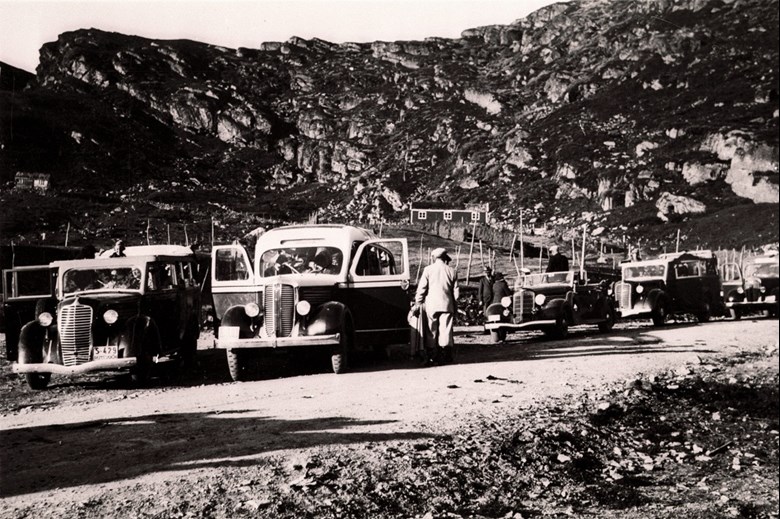"Indre Sogn Automobilselskap A/S" (Ltd.) is established
In 1916, the owner of Hofslund Hotell and coaching inn in Sogndal, Per S. Ness, with other interested people in the district, sent out an invitation to take out shares in "Indre Sogn Automobilselskap A/S". The idea was that the shares should be distributed fairly evenly among the municipalities of Luster, Jostedal, Hafslo and Sogndal. Those who signed the subscription of shares were people like Drægni, Døsen, Knagenhjelm and Walaker. The first automobile bought by the company was a seven-seater Chandler, bought from Bergen. Similar companies had already been established in Lærdal, Nordfjord, and for road traffic between Vadheim and Sandane.
Trial run
The roads were not only narrow, but were steep and had many sharp curves. One of the trial runs during the first year went to Luster. There was particularly one place called Raunereset east of Nes in Luster that the driver, Anton Andersen, feared. However, the company had an agreement with the importer that if the car could not get past this point, they would be allowed to return it. It was a nervous driver who started on this trip with the company board of directors as passengers. It all went well, but before they reached the top, a salute was fired and the driver thought that the car had exploded. At the top of the hill, a banner was strung across the road with the words "Welcome to the top of Raunereset." On their return trip they wanted to try the road up the valley of Jostedalen. There they were met by the mayor who had got hold of a sledge hammer in case there were any rocks that needed to be removed.

Regular summer routes
The car service was started in June, 1916, and later on that summer regular routes were established. The car went four times a week in a shuttle route between Sogndal and Fortun, and once a week between Sogndal and Jostedalen. The service was stopped on 4 September, and in the autumn there were only occasional tours. The company used the same bus schedule up to 1930/31. Only then did improved snow-ploughing equipment make it possible to start a service on a year-round basis. The snowploughing was carried out by the company's own lorries. The snowploughing was first started in the valley of Jostedalen, but before that time private drivers had cleared the roads of snow. This was not always easy; the cars were not heavy enough and the ploughs did not get deep enough. Consequently, there was much ice on the road, which caused a lot of problems during the spring thaw.

Expensive transport - routes for tourists
Travelling was expensive in those days. The first year the fare was 35 øre per kilometre for "ordinary travellers", whereas local people paid only 20 øre per kilometre. Only in 1926 did everybody pay the same fare - 20 øre per kilometre. In 1916, a servant or farmhand would have to save four days' worth of wages to pay for a trip between Sogndal and Fortun. These routes were mainly aimed at the ever-increasing number of tourists who came to the villages of Sogn.
Spring thaw caused problems
There were many practical difficulties implied in the bus service. In spring the spring thaw was a major problem. It was especially old roads with a bad road surface that were most exposed to this problem. The Road Traffic Act of 1926 opened up for limiting or forbidding driving with a motor vehicle during times of spring thaw. Lighter cars could still drive. The municipal councils of both Sogndal and Luster resolved to forbid traffic under these conditions, and Sogndal even banned lighter card from driving. The ban applied to the whole distance of the routes.
In 1926, the Storting (Parliament) resolved that the part of the vehicle tax resting with the counties, could be used for maintaining important through roads, on the condition that the district in question covered one third of the expenses. In Sogn this applied to the roads between Lærdal and Husum, and also between Sogndal-Marifjøra-Skjolden.
From tourist traffic to local traffic
The company found it hard to continue their services due to financial problems. The reason was probably that the number of tourists in this part of Sogn was much lower than in the Lærdal area, for example, where a number of companies operated scheduled services. Even if "Indre Sogn Automobilselskap A/S" in 1920 was allocated an annual sum of 4000 kroner by the government, it was decided to close down the business. The drivers, however, led by Samuel Berge, had other ideas and bought the company and continued the scheduled services. In 1923, the company owned three motor vehicles, and in 1926 five.

"Sogn Billag" is established
There was not much profit in the company, and in order to improve the economy and ensure a better correspondence between the car services and the boat traffic, the local steamship company - "Fylkesbaatane" - took over "Indre Sogn Automobillag" in 1933. A new company was established: "Sogn Billag L/L". The primary concern was to serve the local traffic. Towards the Second World War, passenger traffic increased substantially, and the transport of goods gradually became an important source of income. "Sogn Billag" had come to stay, and by and by it took a major share of the scheduled services in the county.










